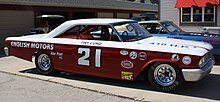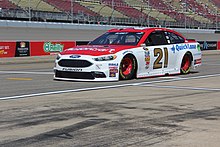Wood Brothers Racing
Walter and Ada Wood, who owned a farm near Woolwine and Stuart, Virginia, had five sons—Glen, Leonard, Delano, Clay, and Ray Lee—and one daughter, Crystal.
Glen Wood cut timber and hauled lumber to local sawmills, and the brothers honed their auto mechanic skills in their father’s garage.
Inspired by Curtis Turner, a local sawmill operator and champion racecar driver known for his "win or crash" style, the brothers formed a stock car racing team.
Drawn by the big cash prizes at Superspeedway races in cities like Daytona, Charlotte, and Darlington, the Wood Brothers shifted focus.
In the early days of racing, drivers would pull into the pits, turn off their cars, step out, and sometimes even smoke a cigarette while the crew took their time changing tires and servicing the vehicle.
Their drivers through the mid-1960s included top stock car racers like Curtis Turner, Marvin Panch, Fireball Roberts, Parnelli Jones, Tiny Lund, Junior Johnson, Speedy Thompson, Fred Lorenzen, and Cale Yarborough.
The Gurney-Wood pairing dominated, winning every race Gurney entered for them, including the Motor Trend 500 at Riverside International Raceway, Moreno Valley, CA in 1963, 1964, 1965, 1966, and 1968.
Due to their remarkable success and exemplary qualities as role models and ambassadors of the sport, the Wood Brothers were invited to the White House in the late 1970s at the request of President Jimmy Carter.
They were often celebrated and compared to top athletes from other sports, such as baseball legend Reggie Jackson, football stars Terry Bradshaw and Franco Harris, and basketball icons Julius Erving and Kareem Abdul-Jabbar.
Bonnett and the Wood Brothers team enjoyed a successful partnership that spanned three and a half seasons and 83 races, achieving nine victories and over $700,000 ($930,766 today) in winnings.
Many original team members, including brothers Clay and Ray Lee Wood, have retired from racing, choosing to focus on their families and other careers in Patrick County.
The Wood Brothers made the decision to transition to a full-time racing schedule, which significantly increased the team's workload and required greater investments of time, money, and manpower.
Recognizing the immense value of NASCAR sponsorship, major companies like Pepsi, Mello Yello, Ford Motorcraft, and Procter & Gamble secured lucrative deals with the sport's top teams.
Alongside the full schedule and championship points races, a new generation of drivers, including Darrell Waltrip, Dale Earnhardt, Bill Elliott, Rusty Wallace, Ricky Rudd, Terry Labonte, and Geoff Bodine, had become powerful stars and champions.
Alongside managing the business and administrative functions, she operated as a "one-woman show," handling all bookings, reservations, accommodations, travel, and financial matters for the team.
Their sole victory came at the 1993 Motorcraft Quality Parts 500 in Atlanta Motor Speedway, a race postponed for six days due to a snowstorm the previous weekend.
Glen Wood’s wife, Bernice, who had served as the family's unofficial archivist since the 1950s, curated an impressive collection of historical items for race fans to enjoy.
A full-time secretarial assistant, Annpaige Bowles, was hired a few years earlier to help manage demanding office tasks and oversee the museum.
To strengthen the workforce, previous hires included William Fulp, John Ilowiecki, and Barry Sheppard, who brought expertise as parts managers, couriers, engineers, and shock specialists.
Eddie and Len Wood made a significant move by hiring Crew Chief Mike Beam, the first non-Wood family member to hold that position for the No.
Hailing from the small town of Stuart in the Blue Ridge Mountains, the team, composed of brothers, relatives, and friends, gained international acclaim as pioneers in motorsport competition.
Racing for owner Jack Roush, Wood quickly earned a reputation as a "racer" rather than just a "driver," thanks to his hard-charging style and his mature evolution into a competitive force.
The son of Len and Nancy Wood, he studied Motorsports Technology at Patrick & Henry Community College while working at the family race shop.
Relocating to Mooresville, North Carolina provided them with better resources and greater access to personnel and technology in the heart of NASCAR racing, leading to significant changes in team composition.
The team secured new primary sponsorship from McKee Foods, while the United States Air Force continued as an associate sponsor alongside Motorcraft.
In 2009, the Wood Brothers competed in a partial schedule, participating in only 13 races after Air Force and McKee Foods switched to other teams, leaving Ford as the sole sponsor through their Motorcraft brand.
Blaney secured his first career Cup Series victory at the Axalta Presents the Pocono 400,[10] marking the Wood Brothers' first win since the 2011 Daytona 500, beating second-place driver Kevin Harvick.
21 truck debuted in 2006 with sponsorship from Edy's Ice Cream and State Fair Corn Dogs at Daytona, driven initially by Stacy Compton for the first two races.
Afterward, Jon Wood took over driving duties at Atlanta, followed by Bobby East, who drove the truck for the remainder of the season and achieved a best finish of eleventh place.
In 1965, IndyCar teams took notice when Lotus owner Colin Chapman hired the Wood Brothers to handle pit stops for his car, driven by Scottish Formula One star Jim Clark, during the Indy 500.

















